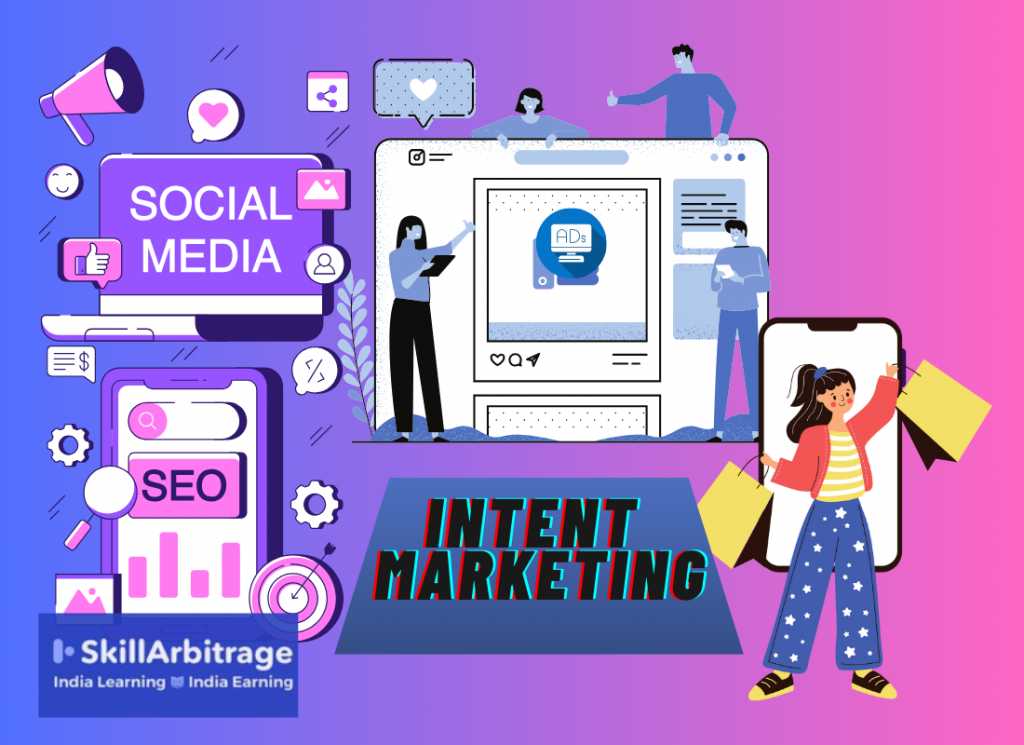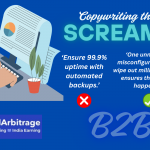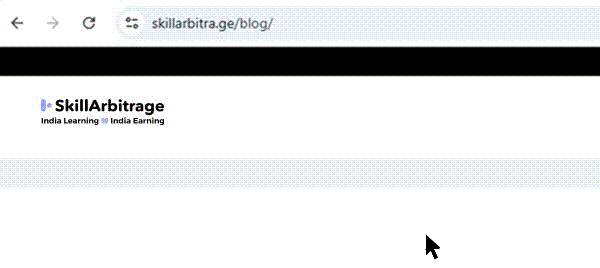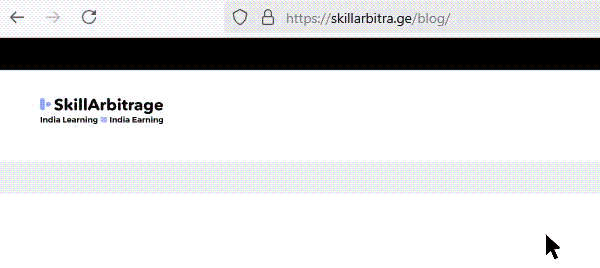This blog decodes the science of Intent Marketing and tells the reader how to use it for small brands on a lean budget. This would be useful for content writers, marketers, and small business and startup owners interested in practically testing out the extremely effective tool of email marketing.
Table of Contents
“But we are a small new brand, there’s no budget,” the client wailed for the nineteenth time. I had been counting.
I swear, if I had a rupee for every time I heard a client say that, I would be a millionaire several times over.
This time, however, it was true—one of those rare cases. The client was the co-founder of a small beauty brand called Glam. They had launched only two years back with a handful of lipstick shades. In a market ruled by such giants as Maybelline and Lakme, and a million other contenders of different sizes, it was tough for a new brand to make its presence felt, no matter how good the product was.
In this case, the product was quite good. They had a nice selection of colours and an extensive matte and glossy range. A small group of customers bought from them repeatedly, proving the merit of the products, but that small pool simply refused to grow.
So they decided to do proper marketing and I suggested drawing up a proper marketing strategy. It was then that they started to have second thoughts. Because, you guessed it, they were a small brand with a minuscule budget.
But I knew just the right thing, the right form of marketing that can solve their problem without stretching their budget too much.
“ You don’t need to have a huge budget for Intent Marketing,” I said.
I was glad to see I had piqued their interest.
“ Intent Marketing, what’s that?” The client asked.
I explained, “ Intent Marketing is a type of marketing that caters to the people who are interested already in your category of product. Makes much better sense than spending a hefty budget trying to market to all and sundry. Gives much better ROI.”
I could see that I had their interest, so I decided to push for the home run.
What is Intent Marketing?
I said, “The idea is based on user behavior, often through data like search queries, website visits, or interactions with content. For example, if someone’s Googling “best running shoes for marathons” or clicking on reviews, they’re signaling intent.
It’s a chance for Marketers like us to swoop in with tailored ads, emails, or content to guide them toward a decision. More like fishing with precision than casting a wide net.
It’s commonly tied to digital tools—like Google Ads with keyword bidding or retargeting campaigns that follow you around after you’ve browsed an online store.
The goal? Higher conversion rates, since you’re talking to people already leaning toward buying, not just browsing.” I explained.
The client said, “ Like OTT platforms suggesting movies for me? Or YouTube suggesting content?”
“ Exactly like that!” I said.
We encounter Intent Marketing on a daily basis.
Places where you have already seen Intent Marketing at work
I. Google Search Ads while looking for a quick fix
- Scenario: You’re rushing to get ready and notice your lipstick’s worn off. You Google “long-lasting lipstick near me” on your phone. At the top of the results, you see an ad from a local Indian beauty store: “Smudge-Proof Lipsticks, ₹250 – Shop Now in Mumbai!”
- How It’s Intent Marketing: Your search query screamed intent—“I need this now, close by.” Google’s AI matched that with a brand bidding on those keywords, delivering a hyper-relevant ad.
II. Instagram retargeting after browsing online
- Scenario: Last night, you checked out a few lipstick shades on a small brand’s website but didn’t buy. This morning, while scrolling Instagram, you see a Reel from them: “Still eyeing that nude shade? Get it today with 10% off!” with a swipe-up link.
- How It’s Intent Marketing: The brand used a Facebook Pixel to track your visit (a sign of intent) and retargeted you with a personalized ad.
III. Email Pop-Up after signing up for a Newsletter
- Scenario: You’re on a beauty blog reading about monsoon makeup tips and sign up for their newsletter with your email. Five minutes later, you get a welcome email: “Thanks for joining! Here’s a ₹100 coupon for our vegan lipsticks—shop now!”
- How It’s Intent Marketing: Signing up showed intent to engage with beauty content, and the brand (maybe your lipstick line) pounced with an AI-drafted email via a free tool like Mailchimp. It’s not a hard sell—it’s a timely offer matching your curiosity.
IV. X post response while asking for recommendations
- Scenario: You tweet, “Any recs for a bold red lipstick that doesn’t bleed? Need it for a party!” Within an hour, a small Indian makeup brand replies, “Our ₹300 red stays put all night—check it out!” with a link and a customer photo.
- How It’s Intent Marketing: Your tweet was a neon sign of intent—“I’m looking to buy.” The brand used basic social listening (even manually searching X) to spot it and respond directly. It’s low-tech but precise capture of sales opportunity”.
“This makes sense on paper, but how does it work exactly?.” The client enquired.
I clarified,“ Say, someone is Googling ‘best long-lasting red lipstick.’ That’s a high-intent query. By a high intent query, I mean that they have a specific sort of product in mind already; they are not generally looking or window shopping. That would have been the case if they were Googling something like ‘best lipstick. But with a high-intent query, the customer is likely ready to buy if they find the right product.”
The client was now really interested, but they wanted to know more.
“ You said something about an intent signal. What’s that?”
I elaborated, “ Intent signals are signs of the customer’s intention. There are three types of intent signals. High, mid, and low signals. According to Microsoft Advertising, consumers who show purchase intent signals are 2.8× more likely to complete a purchase.”
Key intent signals could include any of the following things:
- Search engine queries (e.g., ‘best matte lipstick for dry lips’)
- Behavior on social media (liking/reposting lipstick reviews)
- Website visits (browsing product pages, abandoning carts)
- Email interactions (clicking on discount offers, opening newsletters)”
“There were also different types of intent marketing which will together build the strategy I am suggesting,” I said.
The different types of Intent Marketing
Search Intent Marketing
This strategy is about catching leads when they’re actively looking for something specific.
You bid on keywords like “best matte lipstick India” or “affordable lipstick for dusky skin” via Google Ads. When someone searches those terms, your ad or site pops up.
A customer searches “long-wear lipstick under ₹300,” and your ad says, “₹250 Smudge-Proof Shades – Shop Now!”
Behavioral Intent Marketing
This focuses on what people do online—like pages they visit, items they click, or carts they abandon—to predict their next move.
Tools like Facebook Pixel or Google Analytics track actions on your site. If someone browses your “nude lipstick” page but leaves, you retarget them with an ad later, like an Instagram ad that says: “Still thinking about that nude shade? Get it with free shipping today!”
Social Intent Marketing
This form of intent marketing leverages conversations, questions, or posts on social platforms (X, Instagram, etc.) to spot intent and jump in.
We monitor hashtags like #IndianMakeup or search for phrases like “need lipstick for wedding.” Then, you reply or run targeted ads to those users.
Someone tweets, “Looking for a bold red lipstick under ₹500,” and you respond, “Our ₹300 red lasts all night—try it!” with a link.
Content Intent Marketing
This strategy uses educational or engaging content to attract people who are researching or exploring a need, guiding them towards a specific product.
We create blog posts, videos, or guides—like “Top 5 Lipstick Shades for Indian Skin Tones”—optimized for search or shared on social. It draws in people with early intent.
Someone Googles “lipstick for humid weather,” finds your post, and sees your brand’s “sweat-proof” line featured.
Predictive Intent Marketing (Emerging Type)
This one emerged with AI. This strategy uses AI to guess intent before it’s fully clear, based on patterns in data—like past purchases or browsing habits.
Advanced platforms (less free, but growing) analyze trends and suggest, “This person might want a bold shade soon.” You then preemptively target them.
Someone buys a nude lipstick from you; AI predicts they’ll want a red next and sends an email: “Ready for a bold upgrade?”
The Client: “Okay, this seems very technical and interesting. Are big brands using it?”
I smiled and said “ Oh, you would be surprised.”
Brands that regularly use Intent Marketing
They already knew about OTTs, so I decided to tell them about at least three brands that regularly use Intent Marketing in various forms
I: Sephora
Sephora, the international cosmetic brand, invests heavily in intent-based Google Ads. When users search for ‘best foundation for oily skin,’ Sephora’s blog and shopping ads rank high.
Result? Their SEO strategy contributes to remarkable growth in both traffic and sales. All thanks to really intensive Intent Marketing.
II: Nykaa
Then, there was the steadily growing online shopper’s paradise for lovers of beauty brands and fancy things, Nykaa.
Nykaa uses browsing behavior to retarget users with highly relevant ads. If you check out a Maybelline lipstick but don’t buy it, expect to see ads for it everywhere!
53.57% of the company’s traffic (Website visits) comes from search engines (Ranking content), and they rank for almost 55.12% of organic keywords (top search results), which indicates the significant audience they attract through organic efforts.
That’s some excellent use of Intent Marketing.
III: Amazon’s personalized recommendations
Even the e-commerce mammoth, Amazon, uses AI-driven Intent Marketing, analyzing past searches, wishlists, and abandoned carts to suggest products to users.
The client started to look hesitant again. They said, “ But all these are really big brands, and we are really small. Can this apply to us?”
“ Yes, of course,” I said.
Actually, small brands tend to benefit considerably more from Intent Marketing.
Why do small brands benefit the most from Intent Marketing?
Unlike big corporations that have massive ad budgets, small brands need a high ROI on every marketing rupee spent.
Intent Marketing allows them to:
Compete with bigger brands: Instead of running generic ads, you target only the most relevant buyers.
Spend smartly: You avoid wasting money on people who aren’t interested in buying.
Build a loyal customer base: Since intent-driven marketing is personalized, customers trust your brand more.
Increase conversions: Intent-based marketing strategies show an average of a whopping 93% increase in conversion rates compared to generic marketing approaches.
“ In fact, this was a strategy perfect for a brand like yours,” I concluded.
That really made an impression. The client looked excited now. Always a good sign.
They said, “ That sounds promising. So how do we get started?“
I said, “ In small, quick, and steady steps. Let me walk you through them.”
The step-by-step implementation
Step 1: Defining the audience and intent signals
Goal: First, we need to identify who’s most likely to buy Glam lipsticks and what signals show they’re ready.
How:
Say, our target is women aged 18-35 in urban India looking for ₹200-₹400 lipsticks that last in heat/humidity.
We list intent signals: Searches like “buy lipstick online India,” site visits to product pages, or social posts asking “best lipstick for dusky skin.” using free tools like Google Trends checking “lipstick” trends in India), X search (e.g., “need lipstick for wedding”).
Next, we need to write down 5-10 high-intent keywords/phrases (e.g., “long-lasting lipstick India,” “affordable red lipstick”).
Step 2: Set up basic tracking
Next, we need to capture intent data from the audience’s actions.
How:
We need to create a simple website (use Google Sites, free) with product pages for Glam’s shades (e.g., “Matte Red,” “Nude Glow”) and install Google Analytics (free) to track visits, page views, and bounce rates. We also need to add a Meta Pixel (free via Meta Business Suite) to your site for retargeting on Instagram/Facebook.
Step 3: Create intent-driven content
Then, we need to attract early-stage intent users with helpful content.
How:
We can use ChatGPT (free tier) to draft a blog post like “5 Glam Lipsticks Perfect for India’s Humidity” or a script for a 15-second Reel and post the blog on your site and share a Canva-made graphic or Reel on Instagram with hashtags (#IndianMakeup, #LipstickLovers).
We also need to optimize the content with keywords from Step 1 (e.g., “long-lasting lipstick India”) for search visibility.
Step 4: Launch a small search campaign
Then, we need to target high-intent searchers ready to buy.
How:
We have to sign up for Google Ads (free to start, pay per click) and set up a small budget like ₹500-1000 for a week, bidding on keywords like “buy lipstick online India” or “Glam lipstick price.” Aim for ₹5-10 per click.
Then we need to write a simple ad: “Glam Lipsticks – ₹250, Long-Lasting, Shop Now!” linking it to the site we built.
Step 5: Retarget interested visitors
Next, we need to convert people who showed intent but didn’t buy.
How:
We would use the Meta Pixel data from Step 2 to create a custom audience (e.g., “Visited Glam site last 7 days”). Then design a retargeting ad in Canva: “Missed your Glam shade? Get 10% off now!” and run it on Instagram/Facebook with a ₹200-300 budget for 5 days.
Step 6: Engage on social media
We would also need to catch real-time intent from social conversations.
How:
We need to search X daily for phrases like “need lipstick for party” or “best nude lipstick India.” ad engage with them suggesting our brand if someone’s looking for a good lipstick or asking recommendations for one. We would also post a poll on Instagram Stories from our official handle: “Which Glam shade for your next event? Red or Nude?” to spot preferences.
Step 7: Build an email funnel
The next step would be to nudge high-intent leads toward purchase and loyalty.
How:
We would add a sign-up form to the site via Mailchimp (free tier): “Get a free shade guide + 10% off your first Glam buy!”. We would set up a 3-email sequence:
- Welcome: “Here’s your guide + coupon!”
- Reminder (2 days later): “Your 10% off expires soon—shop Glam now!”
- Follow-up (post-purchase): “Love your shade? Tell a friend, get 15% off next time.”
Step 8: Measure and adjust
The last step is all about seeing what’s working and tweaking for better results.
How
We would:
Check Google analytics: Which pages get traffic? High bounce rates mean weak intent matches.
Review ad performance: Google Ads (clicks-to-sales ratio), Meta Ads (retargeting conversions).
Track: Email opens/clicks in Mailchimp and social replies on X/Instagram.
Adjust: If “red lipstick” ads flop but “nude” ones sell, we would need to shift budget to the latter, for example.
I was sure this strategy would bring in results. For a small brand like Glam, intent marketing is more of a lean, scrappy opportunity.
They can’t outspend the giants, but they can outmaneuver them by focusing on niche intent signals. A small brand might target long-tail keywords—like “handmade leather boots in Vermont” instead of just “boots”—where competition’s lower and intent’s clearer.
With limited resources, they can use free or low-cost tools (Google Analytics, basic retargeting) to zero in on their ideal customers. It’s also a way to build loyalty without needing a huge awareness campaign—get the right people at the right time, and they’ll remember you.
It had:
- A lean start: Free tools (Google, Meta, Mailchimp) keep costs low.
- Intent focus: You’re hitting searchers, browsers, and askers at different stages.
- Scalable: Add budget or channels (e.g., Pinterest) as sales grow.
For Glam, this could mean 10-20 sales in a month if 5% of your 200-400 ad clicks convert (based on typical rates). Start with search and content to build traction, then layer in retargeting and email.
“Wow, that’s impressive! Won’t you need a huge team for this?” The client asked.
“Oh no! There are some interesting tools nowadays”. I replied.
How free tools will help you set this up
These tools, with AI add-ons, could not only help in writing the content but also drive email marketing, find keywords, and provide analytics.
Here are the free tools I intend to use in different stages of customer’s buying journey like Awareness stage (where the customer has intent but no knowledge of the specific brand), consideration stage (where the customer is considering buying the product), decision stage (where the customer is ready to buy and ultimately buys the product.
There were AI tools for the post-purchase stage as well, to create loyalty and ensure repeat sales.
Awareness stage: find and attract curious browsers
- Tool: Google Trends (Free)
- How to Use: Search for terms like “lipstick India” or “matte lipstick trends” to spot what people are curious about. Filter by region (India) and time (past 12 months) to see rising queries like “long-wear lipstick for humidity.”
- Action: Create blog posts or social captions around these trends—e.g., “Why Long-Wear Lipsticks Are a Must in India”—and share them on X or Instagram to catch early intent.
- AI Bonus: The tool’s suggestions (related queries) act like an AI brain, pointing you to what’s hot.
- Tool: ChatGPT (Free Tier via OpenAI or Alternatives)
- How to Use: Ask it to generate content ideas or headlines based on your niche—like “Give me 10 blog titles for a lipstick brand in India targeting humid weather.”
- Action: Use the output to write quick posts or scripts for Instagram Reels, drawing in people searching for solutions.
Consideration stage: target and refine interest
- Tool: Google Keyword Planner (Free with Google Ads Account)
- How to Use: Input terms like “lipstick for Indian skin” or “affordable matte lipstick” to find search volumes and related keywords (e.g., “nude lipstick under ₹300”). It’s AI-driven to predict what people want.
- Action: Optimize your website or product descriptions with these keywords, or run a tiny Google Ads test (even ₹100/day) to see which terms pull clicks. Pair with a free landing page (via Google Sites) to track interest.
- Tool: Canva’s Magic Studio (Free AI Features)
- How to Use: Use the AI text-to-image or Magic Write tools to create eye-catching visuals—like “Top 5 Shades for Dusky Skin” graphics—or ad copy for retargeting.
- Action: Post these on Instagram or Pinterest, targeting users who’ve shown interest (e.g., via hashtags like #IndianMakeup).
Decision stage: convert ready buyers
- Tool: Facebook Pixel (Free with Meta Business Suite)
- How to Use: Add this AI-powered tracking code to your site to see who’s visiting product pages or adding to cart. It learns their behavior over time.
- Action: Retarget these high-intent visitors with a simple ad (e.g., “Grab your shade before it’s gone!”) using Meta’s free ad tools—just upload your Canva design and set a small budget.
- Tool: Mailchimp (Free Tier)
- How to Use: Set up an email sign-up form on your site with an AI-suggested popup (Mailchimp offers this). Send automated emails to nudge buyers—like “Your lipstick’s waiting!”—using its basic automation.
- Action: Offer a small incentive (e.g., “Free shade guide”) to capture emails, then use AI-drafted emails to push sales.
Post-purchase stage: build loyalty
- Tool: Google Forms (Free)
- How to Use: Create a quick survey (“How’s your lipstick holding up?”) and email it post-purchase via a free link. AI isn’t heavy here, but it’s simple data collection.
- Action: Use responses to tweak your offerings and ask for reviews—turn happy customers into word-of-mouth marketers.
- Tool: Hootsuite (Free Plan)
- How to Use: Monitor mentions of your brand or keywords like “lipstick review India” on X and Instagram. Its AI sorts relevant posts.
- Action: Reply to happy customers with a “Tag us in your next look!” prompt, or address concerns to keep loyalty high
“We would also need to track the success of the campaign. We can use free tools like Google Analytics, Facebook Insights, and Shopify reports to see what’s working. And we would simply drop what isn’t converting and double down on what is.” I added.
They seemed happy, finally. “Wow! This seems like a watertight plan!” They said.
I did not tell them, but even something as dreamy as Intent Marketing was not free from its own challenges.
Challenges in Intent Marketing
Data accuracy and availability
Figuring out true intent relies on good data—search terms, clicks, or social posts—but that data can be messy or incomplete. Someone searching “lipstick price” might just be curious, not ready to buy, and free tools like Google Analytics don’t always clarify the difference.
Why it’s a challenge: If you misread intent, you waste effort targeting the wrong people. For your brand, limited access to premium analytics means leaning on basic insights that might miss the mark.
Real-world snag: This means that for Glam, we might target “best lipstick India” and get browsers, not buyers, burning our ₹500 ad budget with no sales.
Privacy regulations and tracking limits
Laws like India’s Digital Personal Data Protection Act (DPDP, 2023) and global shifts (e.g., GDPR, iOS cookie blocks) restrict how you track users. Third-party cookies are fading, and consent pop-ups scare some people off.
Why it’s a challenge: Less tracking means less intent data. Your retargeting ad for someone who visited your “nude shades” page might not reach them if they opt out—or if Meta’s pixel can’t follow them anymore.
Real-world snag: A customer checks the site but blocks cookies, as it often happens, and we lose the chance to nudge them later, shrinking our high-intent pool.
Competition and cost
High-intent keywords (e.g., “buy lipstick online India”) are gold mines, so big brands with deeper pockets bid them up on Google Ads. Even niche terms like “vegan lipstick Mumbai” can get pricey if competition spikes.
Why it’s a challenge: Small brands get outgunned in ad auctions, forcing you to either overspend or settle for less effective, low-intent terms. Your ₹1000 monthly budget might not stretch far.
Real-world snag: A giant like L’Oreal bids ₹50 per click on “matte lipstick,” while we can only afford ₹5, so their ad buries ours.
Timing and relevance
Intent has a shelf life—if we miss the window, the customer moves on. A wedding shopper needs lipstick now, not next week. Plus, our message has to nail their exact need (shade, price, etc.).
Why it’s a challenge: Slow execution (e.g., manual ad tweaks) or generic pitches (“Great lipsticks!”) lose high-intent users who want specifics fast. A small team might struggle to keep up.
Real-world snag: Someone searches “red lipstick for party tonight,” but our ad takes a day to show up—they’ve already bought elsewhere.
Attribution complexity
Tracking which intent signal (search, social post, site visit) led to a sale is murky, especially with free tools.
Why it’s a challenge: Without clear attribution, you don’t know what’s working, so you might double down on the wrong tactic. For your brand, this could mean wasting time on blog content when ads are the real driver.
Real-world snag: Suppose we see 10 sales for Glam, but we can’t decide if they came from “lipstick under ₹300” searches or a Reel, stalling our next move.
Customer fatigue and overload
Bombarding high-intent users with too many ads or emails can backfire—they get annoyed and tune out. Retargeting someone five times in a day feels creepy, not helpful.
Why it’s a challenge: We risk alienating your audience if we overplay our hand, especially with a small customer base we can’t afford to lose.
Real-world snag: A visitor sees our “10% off” ad everywhere after browsing, decides it’s spammy, and blocks us.
For a small lipstick brand like Glam, these challenges boil down to resources and precision. We have free tools (Google Trends, Meta Pixel), but they’re blunt instruments compared to paid suites. Privacy laws limit your reach, big competitors hog the spotlight, and you’ve got to nail timing with a tiny team.
The way out? We need to start small—focus on one channel (like search or social), test cheap, and learn fast.
Conclusion
Despite all the challenges, Intent Marketing is still an excellent way for small brands to improve their sales. Not only do they give higher ROI and reduce ad budget, but they are also excellent in building brand awareness and loyalty by directly speaking to customers. Businesses implementing Intent Marketing strategies see an average 14.6% reduction in customer acquisition costs. This was marvelous for a small business struggling to make an impact.
It would benefit most small brands like it did with Glam and helped me secure the account. Do you want to try it for a smaller brand? Remember to start small and act quick and let us know if my suggestions and the experience with Glam helped.
FAQs
Q.1. How do I track purchase intent if my brand is new and doesn’t have much website traffic?
- Solution: Focus on social intent signals—track comments, DMs, and influencer engagement to identify potential buyers before they reach your site. Use Instagram polls, Q&As, and surveys to gauge interest.
Q.2. What if my target audience is searching for competitor brands instead of mine?
- Solution: Use competitor conquesting ads—run Google Ads targeting searches for brands like Nykaa or Sugar with compelling copy:
- “Better than [Competitor]? Try Glam’s Smudge-Proof Lipsticks at ₹299!”
- Also, partner with micro-influencers reviewing competitor products and show direct comparisons.
- “Better than [Competitor]? Try Glam’s Smudge-Proof Lipsticks at ₹299!”
Q.3. How do I convert users who browse but don’t buy?
- Solution: Use dynamic retargeting ads that change based on user behavior. If a user viewed a product but didn’t add to the cart, show a video of how the lipstick looks on different skin tones. If they abandoned the cart, offer a limited-time discount.
Q.4. How do I use intent marketing when my product is an impulse buy?
- Solution: For impulse buys like lipsticks, trigger intent before they realize they need it by using:
- Influencer marketing to create FOMO
- Social proof ads with real customer testimonials
- Time-sensitive discounts (e.g., “Only 3 left at ₹299!”)
- Influencer marketing to create FOMO
Q.5. What’s the best way to target high-intent users without spending too much on ads?
- Solution: Instead of bidding on expensive high-intent keywords, target users who engage with your niche’s content on social media. Run Instagram and Facebook ads to people who:
- Follow beauty bloggers
- Engage with competitor pages
- Comment on trending makeup posts
- Follow beauty bloggers
Q.6. How do I differentiate between research intent and purchase intent?
- Solution: Look at multiple signals:
- Research intent: Searching “best lipstick shades for Indian skin” → Show a blog post.
- Purchase intent: Searching “Glam lipstick buy online” → Show a direct product page ad.
- Pro Tip: Use heatmaps (like Hotjar) to see what users do on your site.
- Research intent: Searching “best lipstick shades for Indian skin” → Show a blog post.
Q.7. How do I use AI to improve intent marketing for my brand?
- Solution: Use free AI tools like:
- Google’s Performance Max → Automates ad targeting based on intent
- ChatGPT (for copywriting) → Writes persuasive sales copy in seconds
- Semrush or Ahrefs → Finds high-intent keywords
- Emplifi → Tracks real-time social engagement trends
- Google’s Performance Max → Automates ad targeting based on intent
Q.8. What if my users show intent but don’t complete the purchase?
- Solution: Remove friction points:
- Offer Buy Now, Pay Later (BNPL) or Cash on Delivery.
- Optimize mobile checkout (slow-loading sites kill intent!).
- Reduce steps in checkout—auto-fill addresses and save payment details.
- Offer Buy Now, Pay Later (BNPL) or Cash on Delivery.
Q.9. How can I use intent marketing for seasonal sales like Diwali or Valentine’s?
- Solution: Track intent signals 1-2 months before peak season. If users start searching for “best Valentine’s lipstick gift”, create:
- Gift bundles (e.g., “Valentine’s Special Lipstick Kit”)
- Countdown ads (“Only 5 days left for our Diwali offer!”)
- Gift bundles (e.g., “Valentine’s Special Lipstick Kit”)
Q.10. How do I target intent-driven users without annoying them with too many ads?
- Solution: Use frequency capping so your ad isn’t shown 20 times to the same user. Also, vary content:
- First ad: Product demo
- Second ad: Customer testimonial
- Third ad: Discount offer
- First ad: Product demo
Q.11. How do I track offline intent signals for an online brand?
- Solution: Use geo-targeted ads for locations where beauty stores exist. Example:
- If many people visit a local beauty expo, run location-based ads with a QR code for an exclusive online discount.
- If many people visit a local beauty expo, run location-based ads with a QR code for an exclusive online discount.
Q.12. What’s the biggest mistake brands make in intent marketing?
- Solution: Focusing only on bottom-funnel users. Many brands only target “buy now” searches but ignore educational content that builds future intent. Use blog posts, tutorials, and influencer content to nurture users at all stages.







 Allow notifications
Allow notifications
